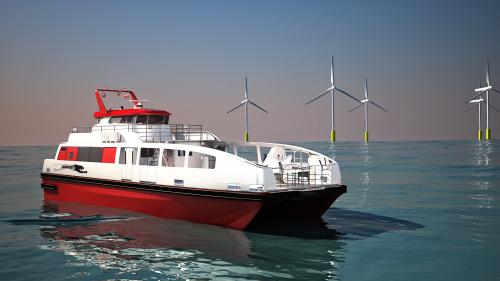
The first CarboCAT, the 23 m CarboClyde, has been in service at the Baltic 1 offshore wind farm of German energy supplier EnBW since mid-September. At a service speed of approximately 25 knots, it can transport up to eight tons of material and 12 to 24 technicians.
Kockums is well known for building naval ships (including the Visby Class 'stealth' corvette) using carbon fibre composite and it has developed its own vacuum infusion process called KVASI (Kockums Vacuum Assisted Sandwich Infusion). It is partnering with Fintry Marine Design AG of Switzerland on the development of a range of CarboCAT commercial catamarans of 18-23 m and 38-43 m which can be adapted to suit different purposes – from sea ambulances to large passenger ferries. Fintry Marine is responsible for marketing the CarboCAT range worldwide.
The concept and outer appearance of the CarboClyde vessel came from Fintry and Kockums carried out the engineering and construction.
“The CarboClyde is the first commercial workboat built entirely using a carbon composite construction technique and is fully classified by DNV," explains Lindsay Leggat Smith, Managing Director of FINTRY Marine Ltd. "FINTRY Marine and Kockums AB thus set new standards, e.g. in reducing the fuel consumption and maintenance costs, increasing the service life, improving the operating characteristics, not to mention providing more safety and comfort for passengers and technicians.”
Kockums and Fintry Marine report that the CarboCAT vessels, which are based on a carbon fibre sandwich composite structure, offer the following advantages:
- 30% or more reduced structural weight compared to aluminium vessels;
- potential fuel savings of up to 20%;
- savings of up to 25% in maintenance costs compared to an aluminium vessel of similar capacity; and
- high safety performance as a result of the composite sandwich construction and double bottom structure.






